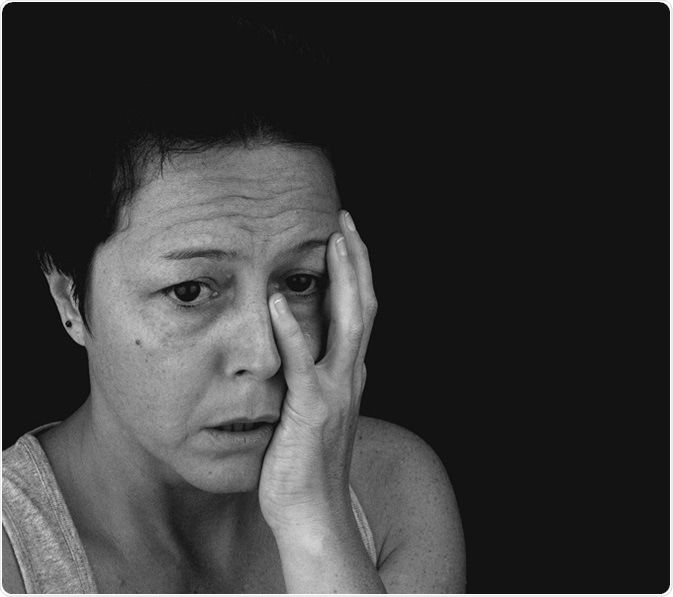Claustrophobia is a fear of enclosed places or physical restriction. It can trigger symptoms of anxiety ranging from mild sweating or trembling to fainting or a panic attack. Common claustrophobia triggers include small rooms, elevators, closets, MRI scanners, airplanes, and other small or tight spaces.

© Sarah Jane Taylor/Shutterstock.com
What is a panic attack?
A panic attack begins abruptly with a fear trigger. The physical symptoms of a panic attack include:
- fast or pounding heart
- sweating
- trembling
- shortness of breath
- choking sensation
- tightening throat
- nausea
- vomiting
- dizziness
- faintness
- chills
- overheating
- numbness
- chest pressure
- pale skin
- pins and needles
- urge to urinate or defecate
- knot in stomach
- butterflies in stomach
As well, emotional experiences that occur in connection with a panic attack include:
- feelings of unreality
- feelings of detachment
- fear of death or insanity
- emotional distress
- confusion
- unable to calm down
- crying
- “freaking out”
Some panic attacks have only a few symptoms. They are known as limited-symptom panic attacks.
Panic attacks are distinguished from ordinary anxiety episodes by the intensity and duration of the symptoms. Panic attacks usually peak within 10 minutes and then subside. Panic attacks can mimic other diseases like heart disease, thyroid disease, or lung disorders, resulting in emergency room visits to rule out a life-threatening issue.
Panic attacks can come on very suddenly during either calm or anxious states. Panic attacks are a feature of panic disorder, but can occur in the context of other anxiety disorders. Panic attacks are very common. In addition to claustrophobia, they can be triggered by other phobias or sources of anxiety, like public speaking.
What causes a panic attack?
Panic attacks are believed to be caused by abnormal activity within the amygdala, the fear center of the brain. Another theory is that activation of a midbrain structure called the periaqueductal gray matter, which regulates defense mechanisms such as running and freezing.
Dealing with a panic attack
If a panic attack occurs due to claustrophobia, there are a number of strategies that can help to stop it. Changing any anxious thinking is an important first step. Think calming thoughts and recognize you are not in danger. Other methods of stopping a panic attack include:
- slow breathing
- relaxing your body
- going for a walk
- focusing on your near surroundings
- reminding yourself that panic attacks are not harmful
- reminding yourself that panic attacks always end
Preventing panic attacks
Reducing overall stress, seeking treatment for anxiety and claustrophobia, and avoiding triggering situations are strategies for preventing panic attacks. Effective treatments are available for claustrophobia. The most common and effective treatment is exposure therapy. This is a form of therapy in which tolerance to the triggering situation is gradually acquired through exposure.
Cognitive behavioral therapy (CBT) is another type of therapy that is frequently used for claustrophobia. In CBT, the patient is guided through strategies for changing maladaptive thoughts that contribute to anxiety.
Panic attacks are sometimes treated with medication such as selective serotonin reuptake inhibitors (SSRIs). Lifestyle adjustments like physical activity, adequate sleep, yoga, and social support can also help to prevent panic attacks.
Sources
- Anxiety and Depression Association of America, adaa.org/understanding-anxiety/panic-disorder-agoraphobia/symptoms
- Anxietycentre.com, Panic attack symptoms, causes, treatment, statistics, http://www.anxietycentre.com/panic-attack-symptoms.shtml
- The efficacy of cognitive behavioral therapy: a review of meta-analyses, https://www.ncbi.nlm.nih.gov/pmc/articles/PMC3584580/
- Cognitive-behavioral therapy for anxiety disorders: an update on the empirical evidence, https://www.ncbi.nlm.nih.gov/pmc/articles/PMC4610618/
- Medical Daily, What happens in your brain when you have a panic attack? How the brain’s fear and threat centers backfire, www.medicaldaily.com/what-happens-your-brain-when-you-have-panic-attack-how-brains-fear-and-threat-centers-backfire
Further Reading